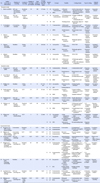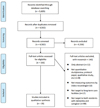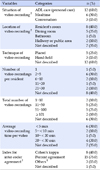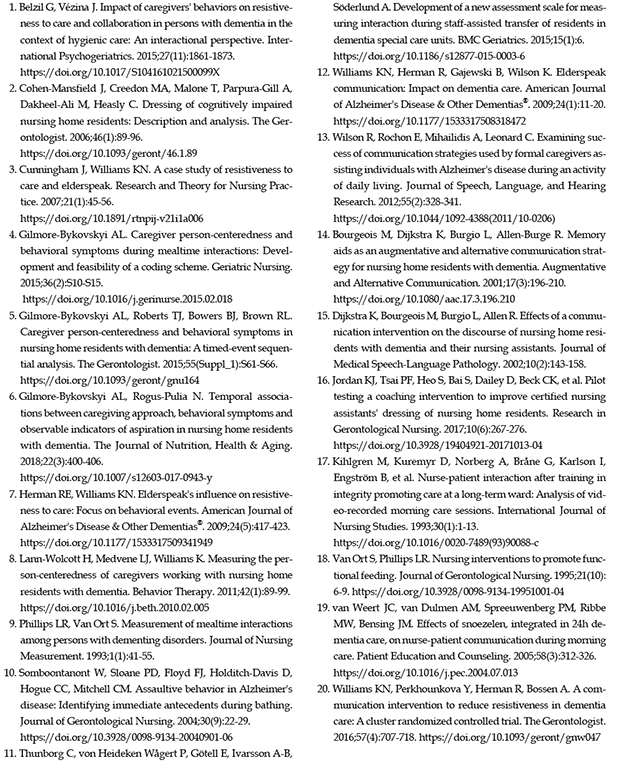DISCUSSION
In this study, we conducted a systematic review of studies that used video-recording to measure interactions between staff and people with dementia in long-term care facilities. A total of 20 studies were included. In terms of study design, 13 studies (65.0%) were descriptive studies and 7 studies (35.0%) were experimental studies. The majority of the descriptive studies conducted sequential analysis of the data to investigate whether there were differences in the risk of certain health outcomes such as behavioral and psychological symptoms in people with dementia according to the care practices or communication of nursing home staff [
68]. If video-recording is applied, the sequential effects of staff behavior on the behavior of residents with dementia can be identified without a longitudinal study design. Thus, video-recording can be so used as a low-cost strategy to increase the feasibility of research [
8]. In addition, the descriptive studies selected in this review also included studies to assess the correlation between staff care practices and resident involvement in care or communication [
1415]. Studies of the development of a coding scheme for analyzing video-recording data were also included [
1617]. In terms of experimental studies, the majority of the studies conducted staff education programs on care practices [
18] and communication [
19]. In some studies, a coding scheme to analyze video-recording data was developed or relationships between variables of interest were identified through descriptive research in the initial stage of the serial study [
2021]. Then, video-recording was used to measure outcome variables to evaluate the effects of interventions in subsequent intervention studies [
19].
Video observation enables researchers to measure the health outcomes of people with dementia, outcomes that are exhibited as responses to the behaviors of nursing home staff. The concepts measured by video-recording for staff included care behaviors such as person-centered care, assistance with activities of daily living, and verbal and nonverbal communication. The measurement concepts for residents included the ability to perform activities of daily living such as feeding and transfer, behavioral and psychological symptoms such as resistiveness to care and agitation, and communication. For example, Williams et al. [
19] used a multi-level model to analyze the effects of elderspeak, infantilizing speech used by staff, upon resistiveness to care in persons with dementia. Somboontanont et al.[
22] conducted a sequential analysis regarding whether nursing home staff showed care behaviors such as confrontational communication, invalidation, or the use of physical restraints five seconds before the occurrence of assaultive behavior by residents with dementia in the situation of taking a shower. They found an association between the assaultive behaviors of people with dementia and care behaviors of the staff [
22]. As described above, observational methods using video-recording have the advantage of enabling researchers to measure interactions between nursing home staff and people with dementia by observing the caregiver's behavior and the response of a person with dementia as a pair of behaviors.
Another strength of the video-recording method is that it can be used to observe the pattern of the particular behavior of a participant in a certain situation [
23]. The video-recording method enables researchers to assess a detailed pattern of behavior when it is difficult to recruit a large number of participants. In this systematic review, 8 studies (40.0%) performed video-recording in a resident's room and 5 studies (25.0%) performed video-recording in a dining room. This result is attributed to the fact that taking videos in a resident's room or a dining room in a long-term care facility makes it easy to observe specific situations such as mealtimes and personal care for the study participants alone.
In observation studies using video-recording, it is essential to design strategies to improve the validity and reliability of coding. To this end, it is necessary to use coding schemes whose validity and reliability have already been demonstrated. When developing a coding scheme, its validity should be verified regarding whether the coding scheme is constructed with concepts that are appropriate for the behaviors to be observed. As careful consideration should be given to strategies for coder training to increase inter-coder reliability and coding accuracy, standardized coder training should be conducted until a certain level is reached according to protocols and reliability criteria [
5]. As for an example of coder training, four observers with previous experience in communication with residents with dementia were trained for one day on the main research concepts such as behavioral and psychological symptoms, person-centered care, and task-centered care, as well as on data cleaning and coding [
16]. Also, coding manuals included guidelines for accurate coding decisions [
16]. The research team met at least once a week to discuss coding schemes that coders had difficulty understanding and to facilitate re-training [
16]. In two studies, coder training was conducted until the inter-coder agreement reached 0.8 and 0.9 respectively [
2024]. A video observation study has high reproducibility because its data can be reproduced repeatedly. This gives it the advantage of higher objectivity compared to direct observation study. However, there is a possibility that coders' attitudes, values, and biases may be involved. Therefore, careful consideration should be taken in making a plan for systematic coder training during the research design process to minimize individual interpretations and increase the reliability of coding.
When designing a video observation study, it is important to note that video-recording itself may affect the behavior of the study participants, such as the Hawthorne effect [
25]. For example, due to the presence of unfamiliar cameras, staff may show different behaviors from their usual ways of providing care or more behavioral and psychological symptoms may occur in people with dementia. To minimize the bias due to the participants' responsiveness, Herman µ Williams [
6] deleted the first 10 minutes of data from video-recordings and only coded the remaining data, considering that the participants may require time to adapt to the setting of video-recording. Williams et al. [
20] stayed in long-term care facilities for one day prior to taking videos in order to allow the participants to adapt to the presence of the camera and investigator. In addition, in one study, the research team took one more video than the required number of videos, and then removed the first recording and coded from the second video file [
23].
In order to conduct research using video-recording with people with dementia, it should be the first priority to consider the protection of participants in terms of research ethics. With respect to the strategies used to protect participants in the included studies, the primary strategy was to receive informed consent from the study participants or their legally authorized representatives before beginning the study. Periodically over the course of the study, investigators checked as to whether or not participants expressed the intention or desire to withdraw from the study. In Gilmore-Bykovskyi [
16], participants were observed every 10 minutes to assess whether the people with dementia expressed a verbal or non-verbal dissent to taking videos. Van Weert et al. [
26] discontinued video-recording when the participant showed a negative response in the middle of video-recording. Moreover, the risk of the invasion of privacy should be minimized because unintended scenes may be captured due to the nature of video-recording. Belzil and Vézina [
27] placed a video camera in the participant's room five minutes before providing hygienic care to minimize recording time. In one study, video-recording for capturing the situation of dressing started after residents put on their underwear to minimize the physical exposure of participants [
14]. In addition, Williams et al. [
20] did not take videos of behaviors with the door closed or with the bed curtains pulled down to protect the privacy of people with dementia. Researchers need to ensure that no residents other than the study participants are videotaped. Gilmore-Bykovskyi [
16] used video editing software to delete the parts of video files including people other than study participants through data cleaning before the coding process. In addition, except for the studies which did not clearly describe the location of video-recording, most of the studies included in this systematic review performed video-recording in a resident's room in order to minimize the risk of unintentionally taking videos of other residents. Since there have been few studies using video-recording in long-term care settings in Korea, the results of this study can offer helpful strategies employed by previous studies to protect the privacy of participants.
This systematic review identified the methodological characteristics of video observation studies focusing on the interactions between people with dementia and staff in long-term care facilities. Based on the findings of this study, we intend to make some suggestions in relation to the applicability of video-recording in Korea and precautions for the use of this technique. First of all, in terms of observational situations, video-recording can be considered to apply to specific situations where one can observe the interactions between staff and people with dementia, such as mealtimes. Some previous studies conducted video-recording of activities such as dressing [
14] and taking a shower in the bathroom [
22]. However, in Korea, research using video-recording is still at a rudimentary stage in this field. So it will be easier to attempt to apply the method to situations with a low risk of the invasion of privacy, such as mealtimes, and take videos in locations such as the resident's room or the dining room [
28]. Secondly, effective strategies for coder education should be established at the research design stage in order to increase the reliability of coding. It is also necessary to include an inter-coder reliability test using an index such as ‘percent agreement’ or ‘Cohen's kappa’. In addition, coding schemes whose validity and reliability have been previously demonstrated should be used. If existing coding schemes are difficult to apply to the research concepts to be observed, it may be necessary to conduct research to develop a coding scheme. Third, in order to minimize the Hawthorne effect caused by the presence of video-recording, it is recommended to use strategies such as excluding the first video-recording data from analysis. Finally, to protect the study participants, it is necessary to obtain informed consent from participants and make a plan to collect data to minimize the risk of invasion of privacy.





 PDF
PDF ePub
ePub Citation
Citation Print
Print







 XML Download
XML Download